Guitars
If you are serious about playing guitars, you eventually end up with numerous guitars. You probably sell some, and you buy others.
I am not the type that likes to sell my stuff, and when I do I usually regret it. Every instrument tends to get an identity and become
a thing of personal affection to me. Those are the symptoms of a hard-to-cure collector. Don't go there!
Here is a chronicle of the guitars I currently play.
Guitars made in Japan
In the seventies, when I learned the guitar, japanese made guitars were marketed as budget instruments. Original american made
guitars were way too expensive, so any guitar that looked like the ones they played on TV, or on pop posters, or in Beat Instrumental
would fit the bill. This is what the japanese figured out, so they built budget instruments for my generation. I have a number of these
japanese made instruments in my possesion, though I never thought of it as a matter of collecting. It was rather to have access to a
different shade of sound. But it is fun to discover that these instruments now have their own collectors mojo.
The japanese factories did build some original designs, but their primary business lay in churning out lots of copies of original american models
from companies like Fender, Gibson and Rickenbacker. At the time these guitars were not held in high regard. I remember many a instrument
review in magazines like Beat Instrumental, where these guitars were deemed reasonable at best. And quality did vary a lot. Things were
not made easier by the japanese practice of buying and selling parts between the different factories. So guitars would end up being pieced
together from parts from several factories, that would otherwise produce competing brands. Furthermore, alle these guitars were sold under a
myriad of names. Often a european or american importer would order a batch of guitars branded specifically for that importer. So even the same
guitar might be sold under a number of different names, which makes collection of japanese guitars very confusing.
Then came the infamous lawsuit in 1977, where Norlin, owner of Gibson, sued Ibanez for the use of Gibsons headstock design. The copies had become
too good, and the american companies started to feel threatened by the japanese invasion. Guitars made before the lawsuit, are popularly known as
"lawsuit" guitars. After this point in time, japanese companies restyled their copies, and eventually phased out production of copies in favour
of original designs. A few companies, such as for instance Yamaha, Washburn and Ibanez, went on to enjoy great success with their own quality designs.
Fast forward to the present, and guitarist have now discovered that a lot of these japanese guitars were actually of excellent build quality.
This has started a wave of collecting on a budget, which has again driven the prices of japanese guitars up. But not everything japanese made is
good. It can be hit or miss. You never know until you play the instrument. Collectors of these instruments focus more on identifying the
manufacturing plant than on the brand name, since some factories maintained a consistently higher build quality than others.
Angelica LP copy
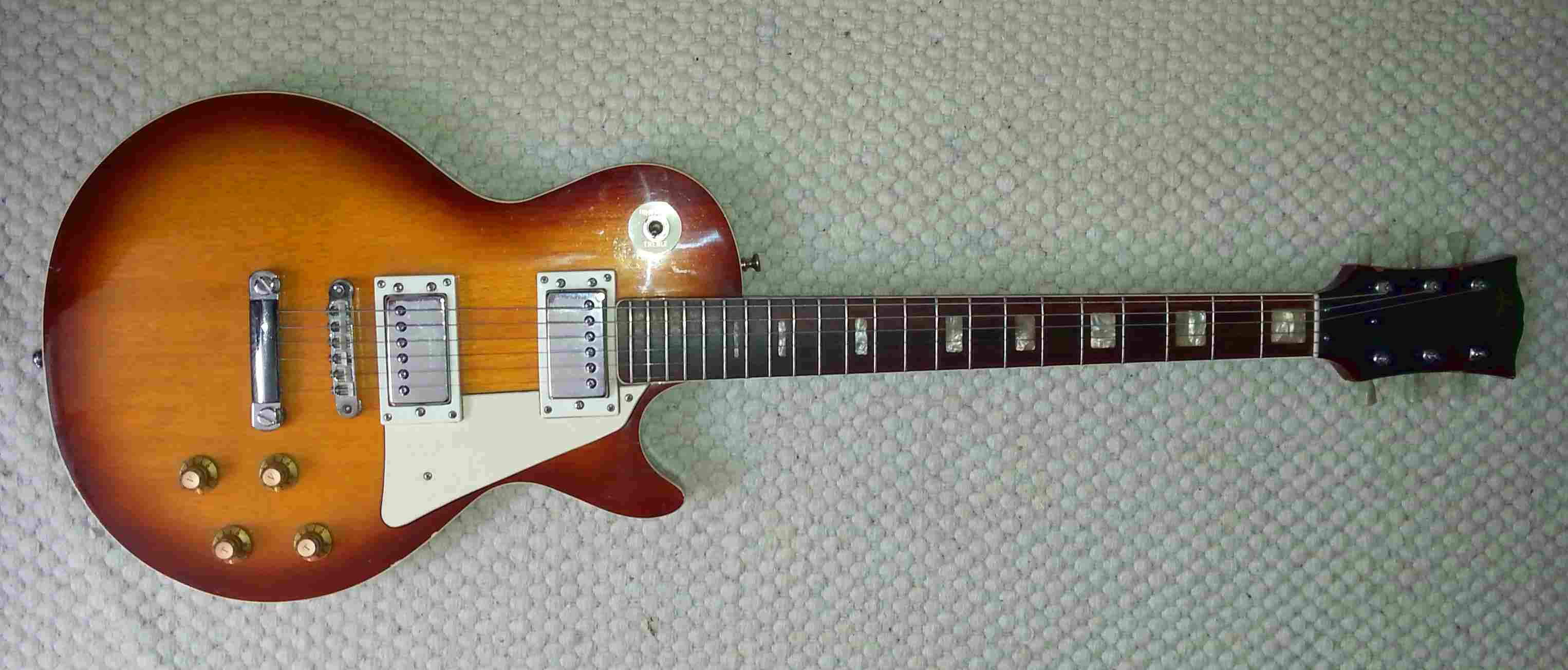
|
This is a very early japanese copy of a Les Paul. It is not a very accurate copy, and the pickups are not humbuckers.
It is nevertheless a nice guitar. The neck feels good, pickups have a good sound, and the headstock is regular lawsuit.
As far as I have figured out, the manufacturer was a company called Tombo. They made guitars between '65 and '75, so this is
an early copy guitar. The knobs are not like Gibson, but are a tall, pointy type that I have seen referred to as Univox knobs.
Apparently a large number of Univox branded guitars were fit with this type of knob.
|
CMI Melody Maker MM20
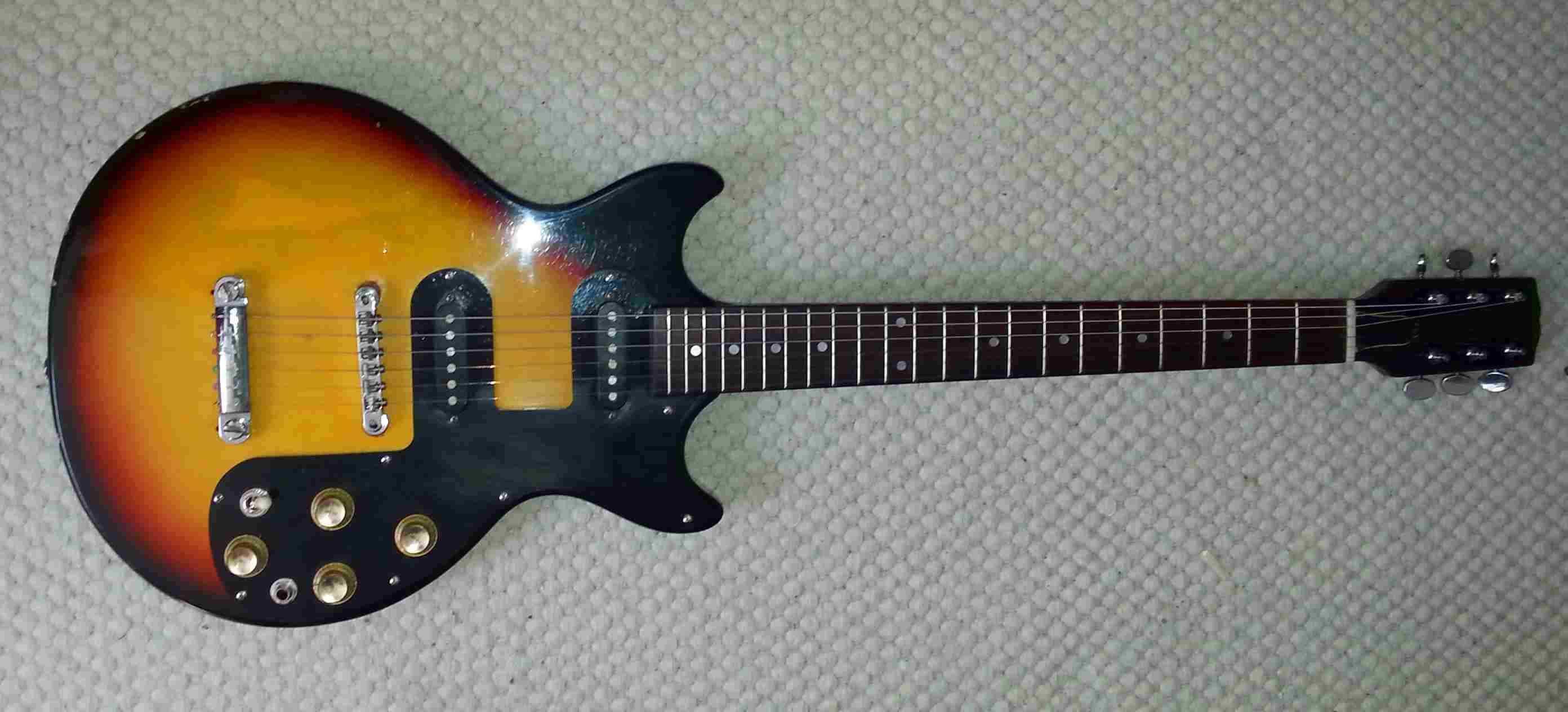
|
This was my first electric guitar, bought new in 1978. The guitar is a copy of the two pickup Gibson Melody Maker model D, with
two single coil pickups that sound really nice and toppy. It sounds nothing like Fender guitars though.
CMI was a vanity brand for the UK importer Cleartone, and some of their guitars found their way to Denmark as well through Brdr.Jørgensen,
which apart from having exclusive rights for Roland products, was also a danish instrument retail chain. The official model name from Cleartone was MM20
("Melody Maker 20"), as it was sometimes present in the price index of Beat Instrumental, and was mentioned in the BMITF Survey in the Aug 1976 issue as a
new model, having been introduced late-75, early-76.
According to the September 1976 issue, p.58 of the same magazine it was modestly priced at £61.38.
This guitar must be categorized as a "lawsuit" too, as the headstock is identical to the Gibson original. I believe the guitar may have been built
on the Moridaira plant. Cleartone also marketed brands Melody, Miami, Guyatone, Klira and Hashimoto, which may indicate more about origins.
It also appears identical to the "Univox Limited Edition Series", though I do not know anything about possible common origins.
I sold this guitar to a friend in the late 80'ies, thinking I would not miss it. But I was wrong of course. In 2012 I found another exactly
like it that I bought, slightly overpriced, and I made it playable again. Funny how everything about this guitar just comes natural to me.
It is clear that this is the guitar I grew up on. The only thing not original on this one is the tailpiece. The original tailpiece was
a stop bridge tailpiece.
|
Ibanez 2351M LP copy
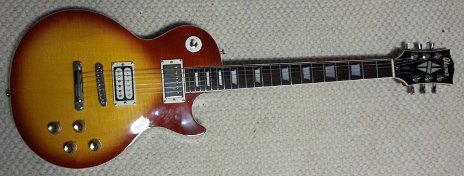
|
A nice clean example of a true "lawsuit" Les Paul - the Ibanez 2351M. This one has the open book headstock and logo, which was the
subject of the Gibson lawsuit. A very nice guitar with "Super 70" pickups, which where produced by japanese manufacturer Nisshin
Onpa. It has bolt-on neck, but purism aside it is a great and playable guitar, and the pickups have great sound.
Ibanez guitars have their own following, because they were generally well-made instruments.
|
Ibanez 2402 6/12-string
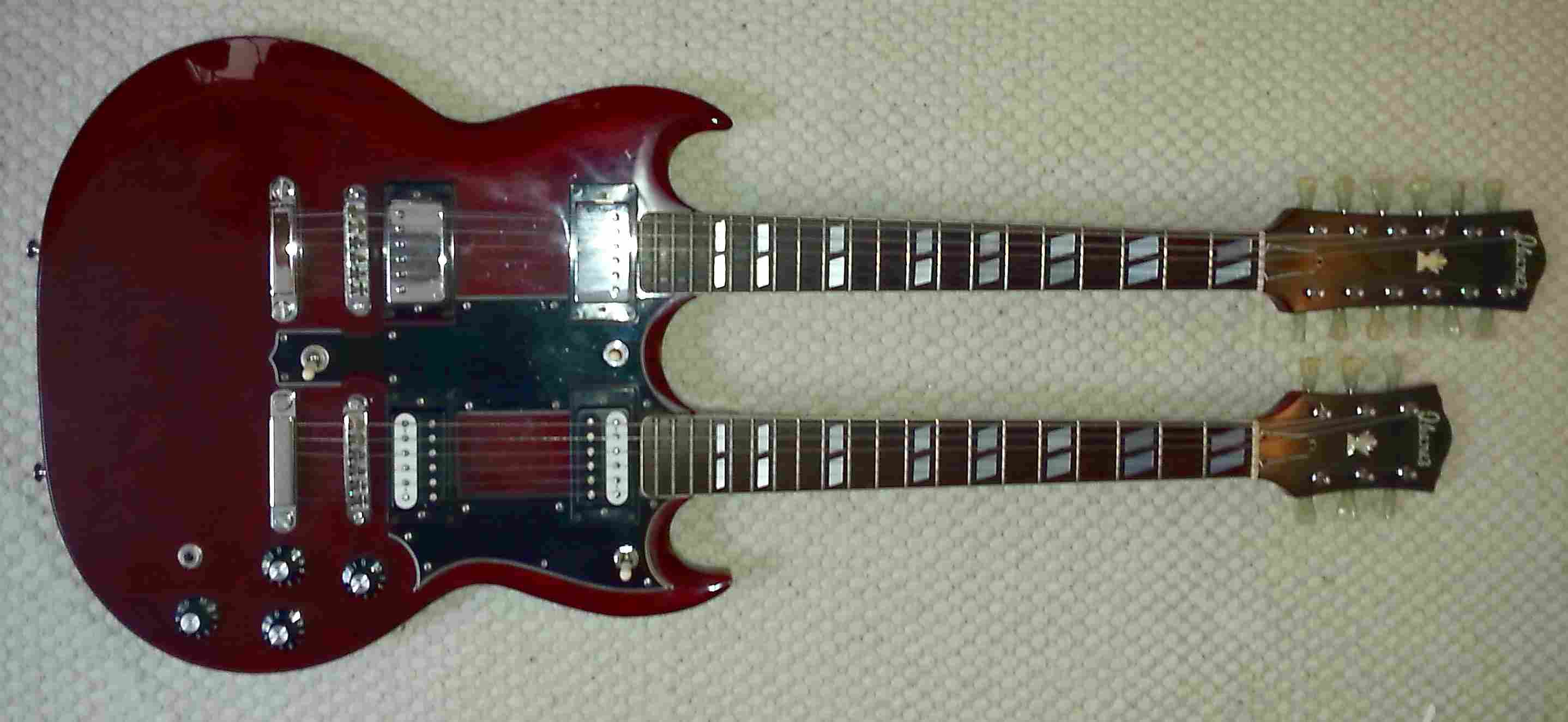
|
In the mid-80'ies I was really into prog, and I wanted a 6/12 double-neck. The local guitar shop had a really nice cherry red SG styled
double-neck for sale at a very reasonable price. Story is, that it had been imported to someone who decided he didn't want it after all, and
then it had been around the shop for a long time. It must have been. The guitar is an Ibanez 2402, which is a copy of the Gibson EDS-1275.
Ibanez guitars had serials, and mine was manufactured in 1978, and so it must be one of the very last, and best, of Ibanez' lawsuit-era guitars.
Or maybe I should say post-lawsuit-era. In 1978 the Ibanez suit was already settled, and actually the headstock is not exactly like the Gibson.
And there are other details that differentiate this guitar from the Gibson. So it would be fair to say that this is a Gibson-like double-neck.
70-ies Ibanez guitars were made almost exclusively on the Fujigen factory, and I assume this is also the case for my 2402.
The Ibanez doubleneck is a really marvellous quality instrument. Both necks sound really good, and in my opinion has nothing to be ashamed of
when compared to an original Gibson EDS-1275. Pickups are "Super 70"s. Finish is also very nice. A fine instrument overall.
|
Jedson "BlackBeauty" LP copy
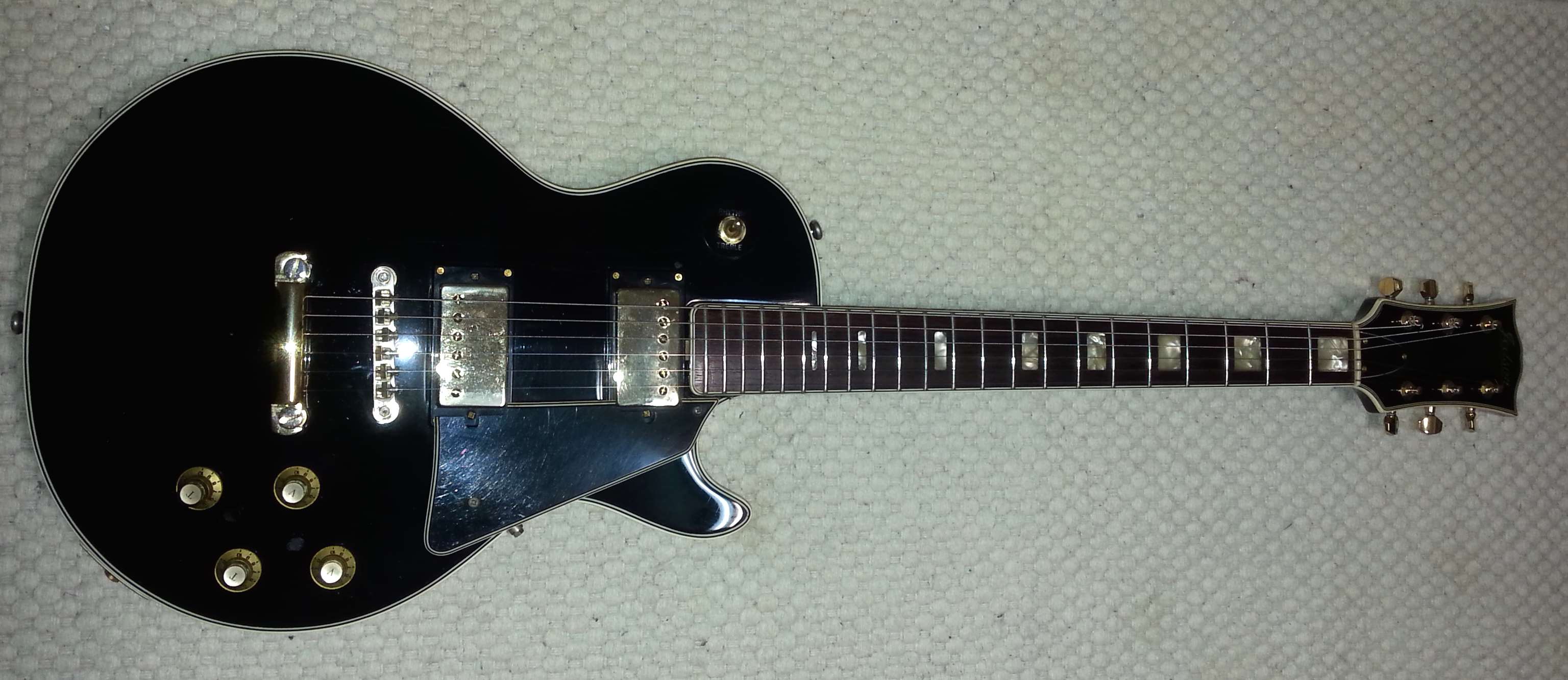
|
Another "lawsuit"-era guitar. This is a copy of a Gibson "Black Beauty" Les Paul, branded "Jedson". It was made in Japan, but the origins is a bit of a mystery. The "Steel Adjustable Neck" neck plate points in the direction of Matsumoku, although that was, I think, "Steel Reinforced Neck". However every detail of this guitars is identical to Ibanez 1970-71 guitars, and those were made at the Fujigen factory. The knobs are exactly the same strange "univox knobs" as my late-60'ies Angelica LP shown above. Recently I came across an old Ibanez labelled guitar which was almost identical to my Jedson. Even down to the univox-knobs, and details of the binding. The plate on the back had only "made in japan" stamped. But then I realised that my Ibanez 2402 has two plates (obviously) - one stamped "made in japan" and one stamped "Steel adjustable neck" with serial no. So, I conclude that this Jedson was probably made in the same factory as both the Ibanez black beauty and my double-neck.
Check out this comparison of the two guitars.
Many UK imports were also sold in Denmark, just like the CMI Melody Maker above, and this is probably how it arrived in Denmark. The "Jedson" label seems to have been a vanity brand for UK importer Dallas-Arbiter. ("Jedson" = "J.E.D.son" = "John E. Dallas and sons"). The Jedson label is said to have been used in the period 1968-75, and this dates my guitar to the early 70'ies.
This Jedson LP seems very well made. It is made of heavy wood, and the playability is good. I don't know what the original pickups were, as someone had put Epiphone PUs in, but if my theory is corect, and this really is an Ibanez, then the PUs may have been Super 70s, which could explain why they were removed. I changed the Epiphones for a set of Seymor Duncan Whole Lotta Humbucker.
|
Santana Strat
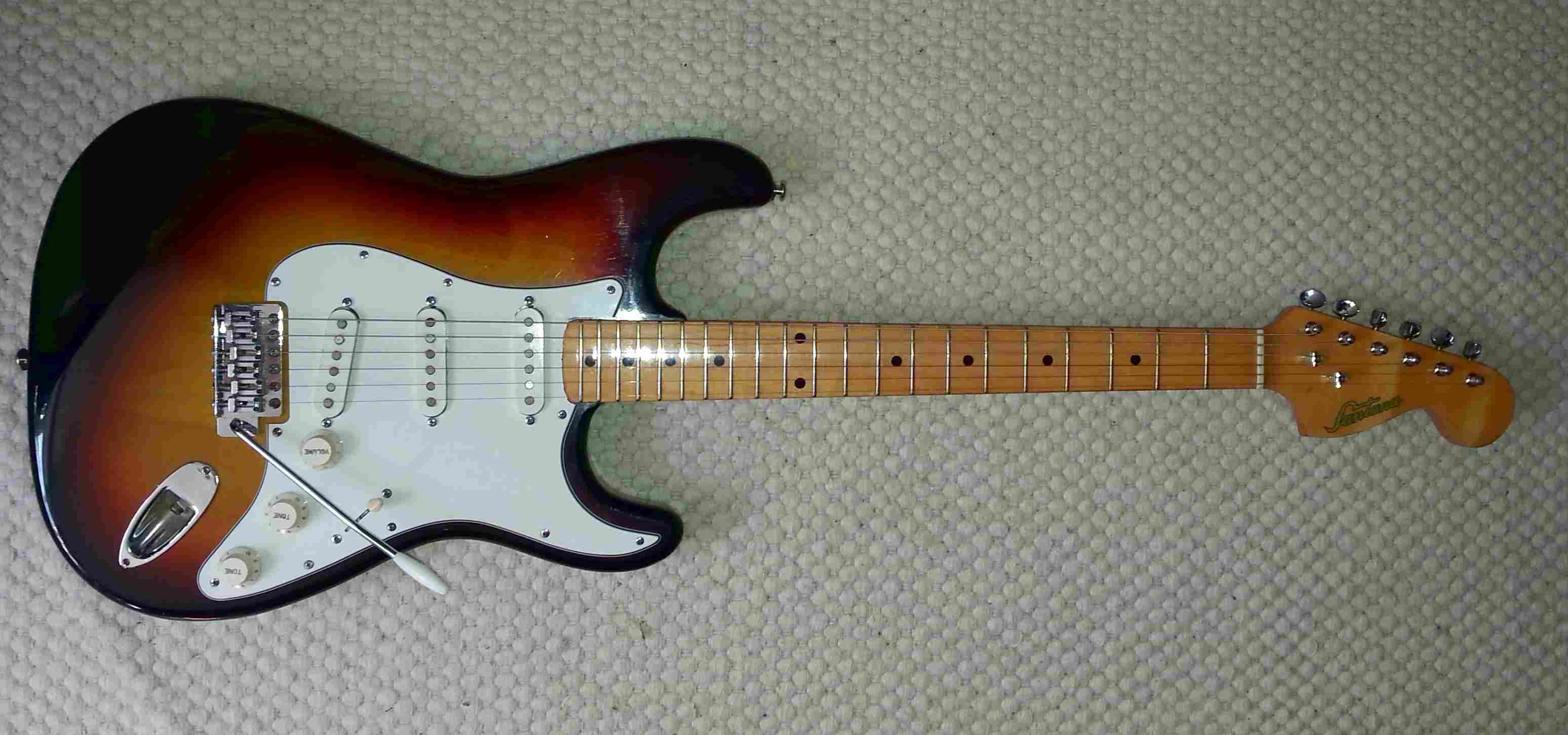
|
A recent acquisition, this is my mystery japanese guitar. I was looking for a budget strat type guitar, and wanted an old japanese one instead
of a new Fender Squier. Then I came across this one. Santana was another importer vanity brand, this time for a danish importer. I can find
Santana guitars in old catalogues from Alfred Christensen in 1977 and 1978. But since the brand was stuck on to many different import guitars,
Santana guitars can be anything from gem to crap. And I have no idea who built it.
This particular Strat seems like a good one. The wood feels nice and heavy. Finish is pretty good too. I particularly like the finish on
the neck. The fretboard is a bit too flat, and it requires some getting used to. On the other hand, the pickups seem to be
AlNiCo, and they sound incredibly good. The original switch was a 3-way, but I changed it to a 5-way switch. I just got to have access to
those phased two-pickup settings. Surprisingly, the vibrato is pretty good too, and manages to keep the guitar in tune after a bend.
One of the best buys I have made.
|
Washburn Falcon
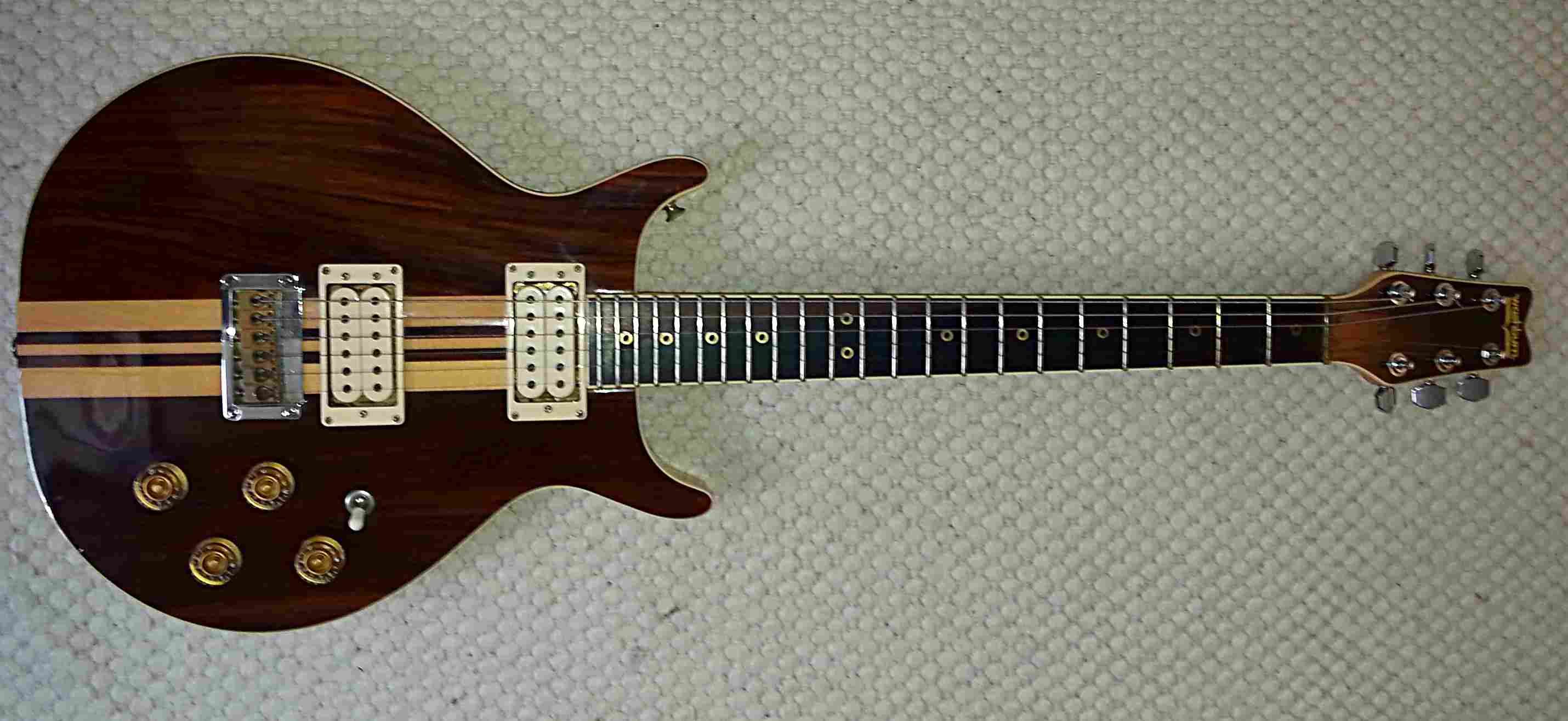
|
My buddy owned this guitar when we played back in 1980-83, and I bought it from him. I just though it was a magnificent guitar. I still do.
Washburn hit the market in 1978, with a series of original designs, the "Wing series". I still have the original flyer ad.
These guitars were all built to very high standards. When you pick it up you can just feel that you have a quality instrument in your hands.
Wood is heavy, finish is thick, all hardware is top quality, and it came with a set of diMarzio humbuckers, with phase inverter switch built into
the volume pots. Neck goes all the way through the body. A powerful and versatile guitar. It is among the first "modern" japanese guitars,
and though it has a body shape not unlike Hamer guitars, it really is a unique and reckognizable design, fit for the 80'ies. The Wing series were made at
the Matsumoku factory.
Another friend of mine had the very similar Hawk model, and in my opinion all the guitars in this series - Hawk, Falcon, Eagle and Raven - are all top quality guitars, and definitely underrated.
|
Yamaha FG-160
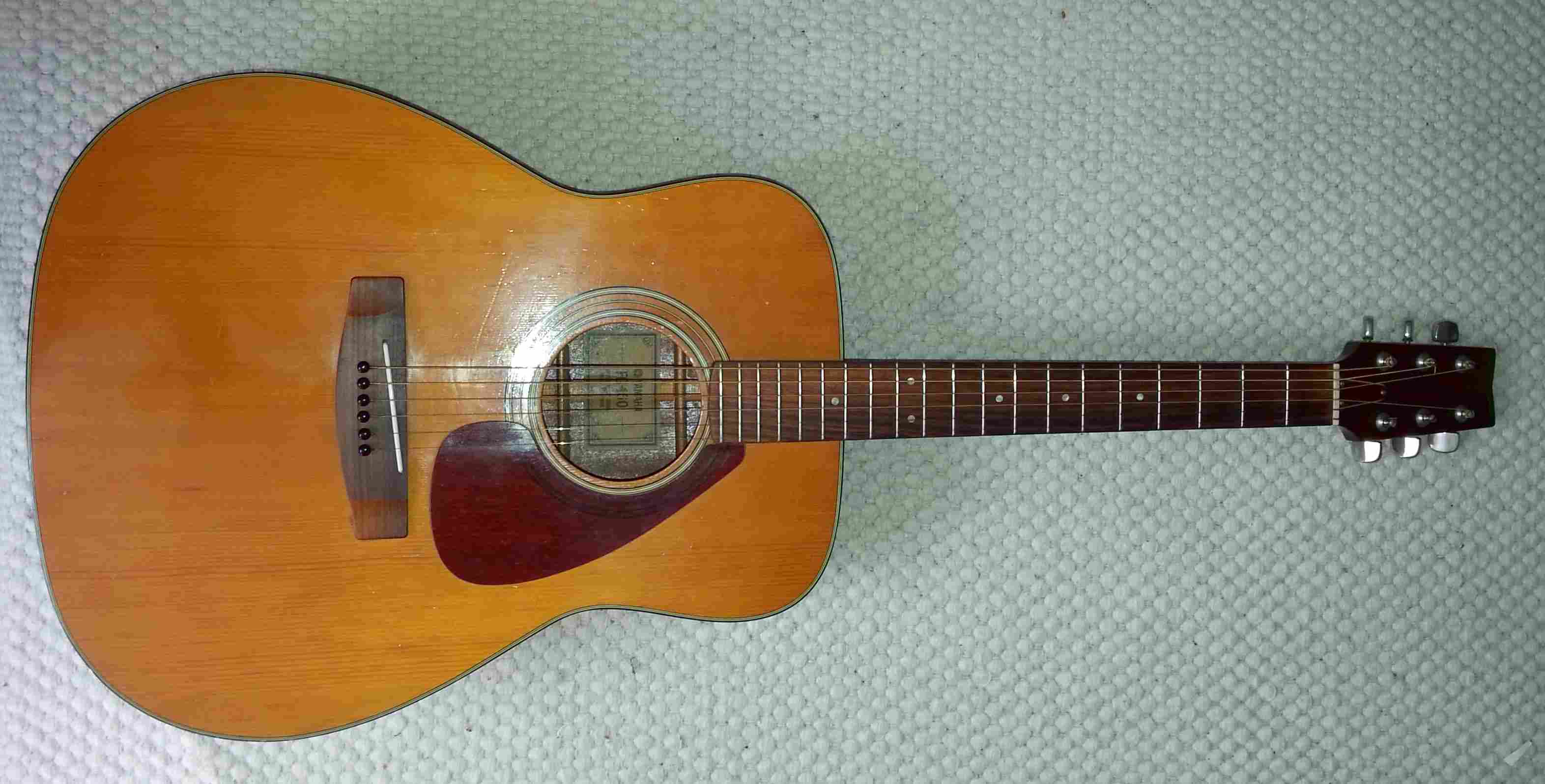
|
Now here is a lovely acoustic! The Martin factories were proud of their craftsmanship, and generously shared their experience with
visitors, such as the people from Yamaha. Yamaha really understood what they saw, and from around 1972/73 they started to build a
series of acoustic guitars acoustic properties very similar to the Martin guitars. The FG-160 is a dreadnought model, sounds very
powerful, and records incredibly well. From what I can read, this one must be from 1975.
The FG guitars from Yamaha develop a problem with bellowing, but in some cases this can be adjusted. Mine has had some work done
to reduce the resulting high action.
The Yamaha acoustics are similar to Martins, but I would not dub them copy guitars. They are just damn well made japanese guitars.
|
Guitars made in America
American made guitars are usually of a high build quality. They are also much sought after guitars, which is not only testified by
their price, but also by the extent to which these guitars have been copied. But even american made guitars come in varying degrees of quality.
Big names like Fender and Gibson have periods of their existence, especially in the 70'ies and onwards, where corners were cut in production,
and quality was suffering equally. This can sometimes be an argument for buying a quality copy guitar. Both companies have, however, picked up on the
entry level market, and introduced their own budget labels Epiphone and Squier.
One american company never compromised, and that is Californian guitar maker Rickenbacker. Though it could be argued that some of their instruments
during the 70'ies also were manufactured too quickly to meet standards, the general picture is that Rickenbacker have produced high quality
instruments most of the way through. The japanese factories also built copy Rickenbackers, especially copies of the 4001S bass, but Rickenbacker
has always been very protective about their brand and their guitar designs, so Rickenbacker copy guitars are usually from the lawsuit era, or
are produced out of reach from Rickenbackers lawyers.
No surprise, that when it comes to Rickenbackers, only the real thing will do for me. Both the feel and the sound of these guitars is unique.
Rickenbacker 365
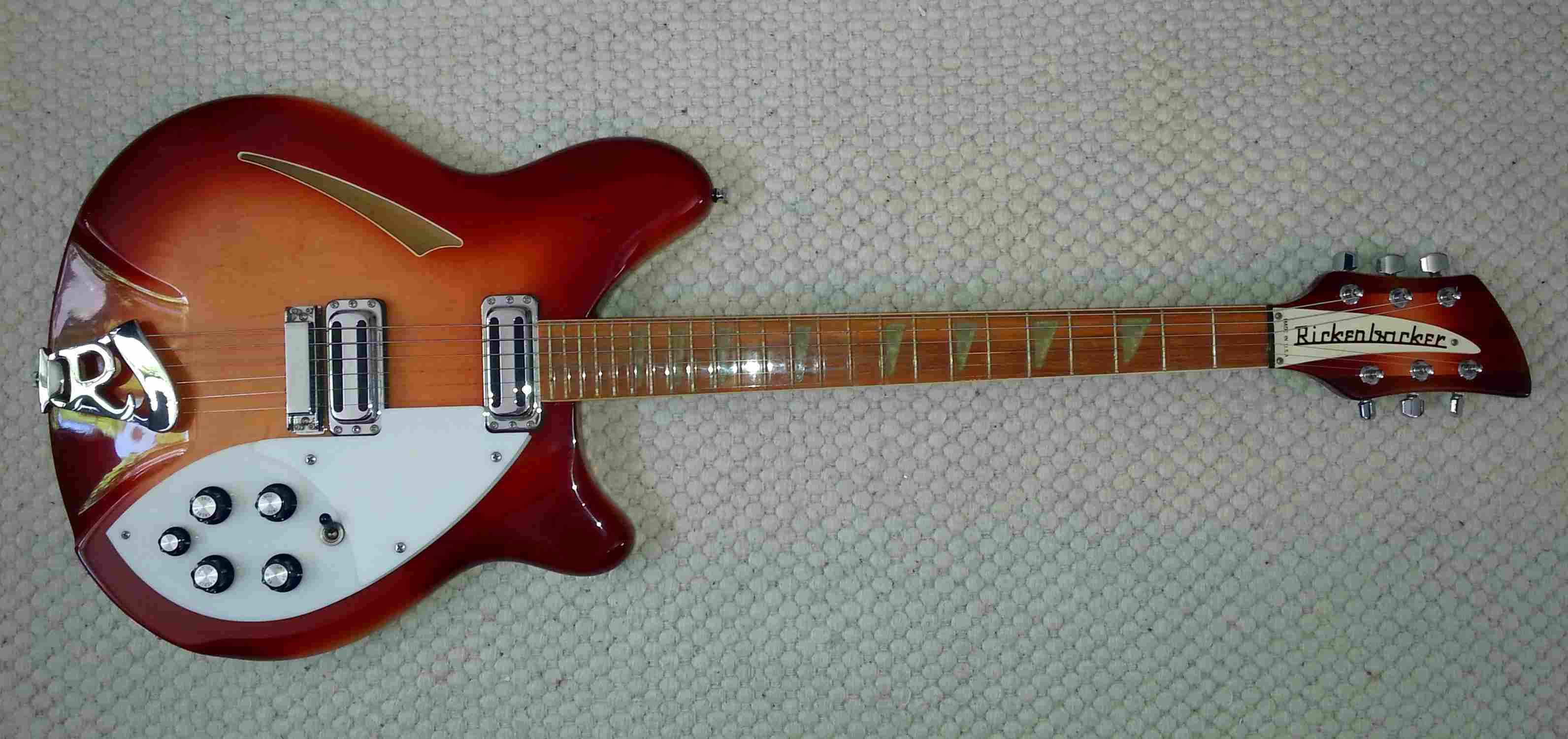
|
I bought this beautiful fireglo model 365 new in 1993. At that time it was still possible to get new Rickenbackers here. Since then
Rickenbacker have decided to make life difficult for european customers, and they now have absurd long waiting lists for overseas buyers
of new instruments.
This guitar came equipped with the not-so-common "toaster"-pickup. The "toaster" was the pickup type used on Rickenbackers in the 60'ies.
Its sound is thinner and has less output than modern Rickenbacker pickups. The toasters made today, though, are made with more
windings than the original 60'ies toasters, and have more output. Some people have unwound windings on modern toasters, to achieve a
the same impedance as the original 60'ies pickups, but I prefer to leave it in its original state.
The Rickenbacker model 365 is a beautiful instrument, that plays great with a sharp and precise tone. The preferred guitar for tone
like that of John Kay of Steppenwolf, John Fogerty of Creedence or Peter Banks of Yes. Not to mention the great John Lennon of course.
|
Rickenbacker 360/12
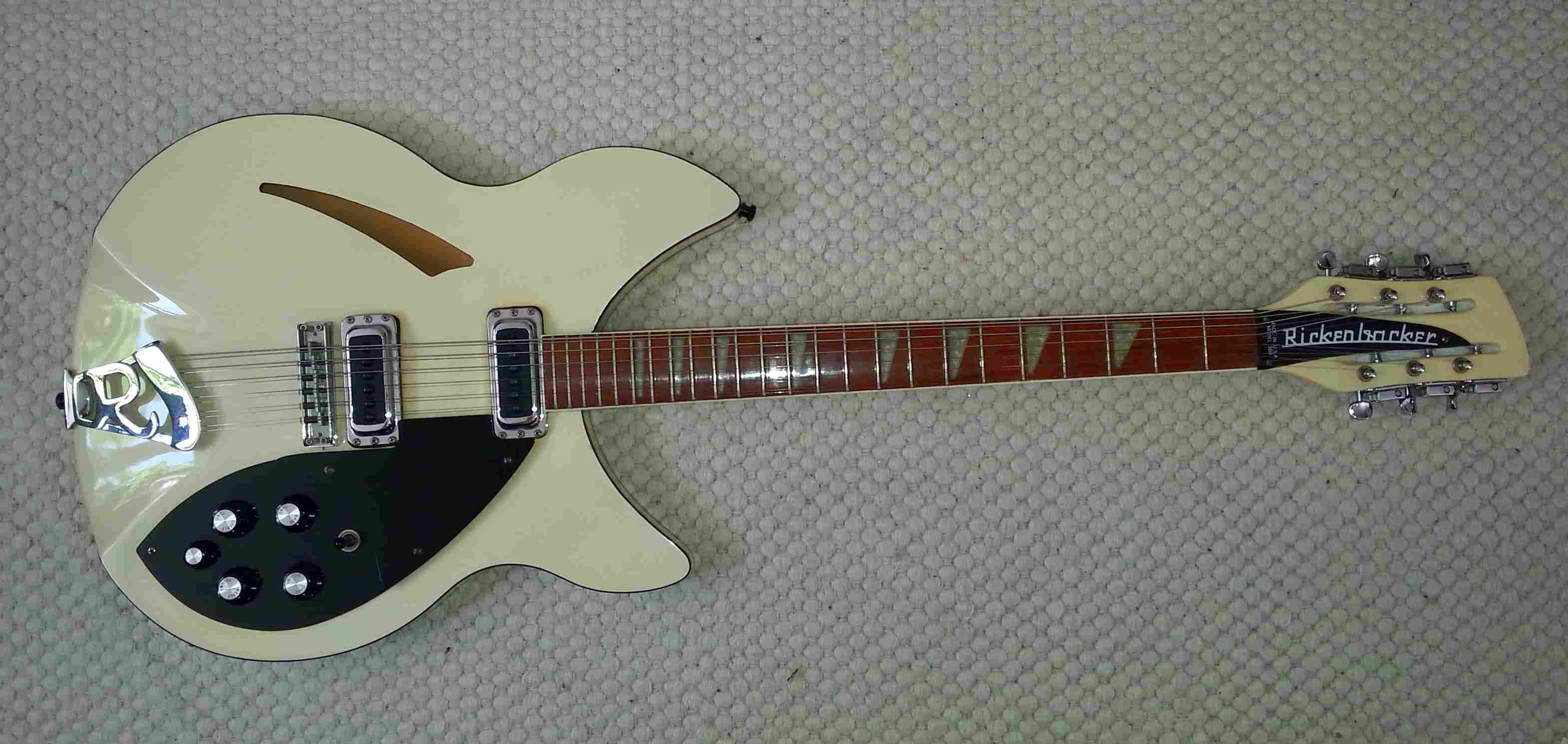
|
No matter how great tone you get from a six string guitar, the undisputed kings of Rickenbacker sound is their 12-string
electrics. The most classic of all these guitars is the fireglo 360/12, pioneered by the late George Harrison. The 1964 version of the 360/12
used by GH was cosmetically different from the ones put in production just a few years later, where the body shape got more rounded,
just like my 6-string 365. Later Rickenbacker also started to use their own humbucker type pickups. In later years Rickenbacker has issued
a retro version of the 360/12 called 360v64/12, with the original features back.
My 360/12 is from 1984, and has a number of unusual Rickenbacker features. It is white, which wass common in those years, but with
black bindings. The body shape is like a 360v64, the fingerborad is rosewood with triangular inlays, the hardware is chrome and the
plate is black. This is not a combination I have seen anywhere else. I suspect my guitar may have been ordered with this custom combination,
as this is possible at Rickenbacker, but at least it is a unique guitar.
The sound is, as you would expect, ringing clean, characteristic and instantly reckognisable. It is surprisingly easy to play, but you
have to cut your nails, as the hard lacquer does not give away to pressure. Otherwise it almost feels like playing a six string. The only
guitar, if you need the sound of George Harrison, Roger McGuinn, Pete Townsend, Tom Petty, Mike Rutherford, and countless other major
and minor artists that all know that this guitar is the only source to that sound.
|
Rickenbacker 4001S
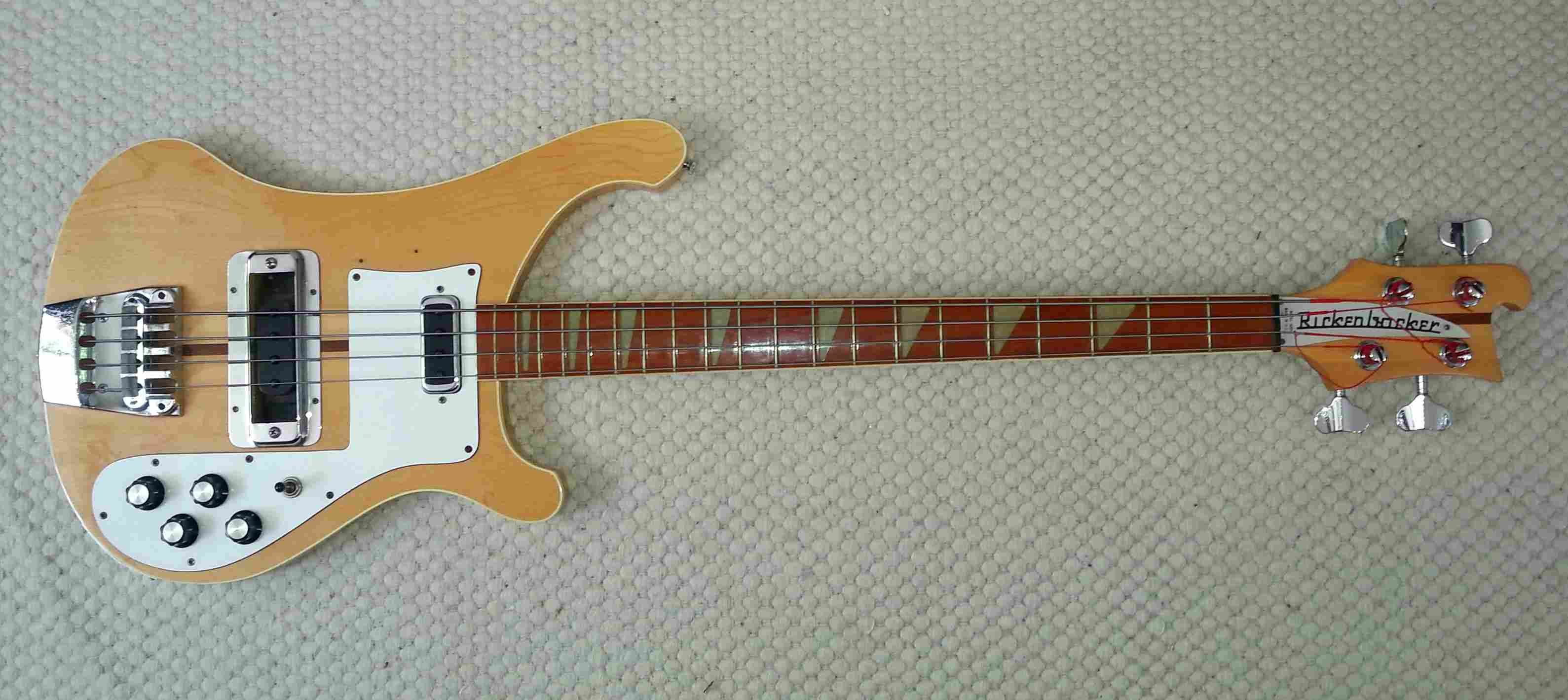
|
Rickenbacker made another instrument, which is as much a classic as the 360/12, namely the 4001S bass guitar. And just like the 360/12
became a classic in the hands of George Harrison, the 4001 became a classic in the hands of Paul McCartney. The 4001S bass guitar
quickly became a widely used bass guitar, with prominent users such as Roger Waters of Pink Floyd and not least Chris Squire of Syn and
later Yes. With the 4001S, Chris Squire took the bass guitar to a totally different place in rock music. One of the things that make
the 4001S such a great instrument is its versatility. It has a double set of volume and tone controls, like a guitar, and the fundametal
tone of the bass guitar is both boomy and toppy at the same time. This bass guitar can be pushed all the way to the front, which is
exactly what Chris Squire did. But it can also take the role of an accompanying instrument, like Paul McCartney did. A very versatile
instrument indeed. It gets its most characteristic sound when picked. Combine that with a driven valve amplifier with plenty of treble,
and you are off to some serious rock bass playing. The 4001S has so many promient users, that it would be pointless to list them.
|
Guitars made elsewhere
Fender Squier Telecaster
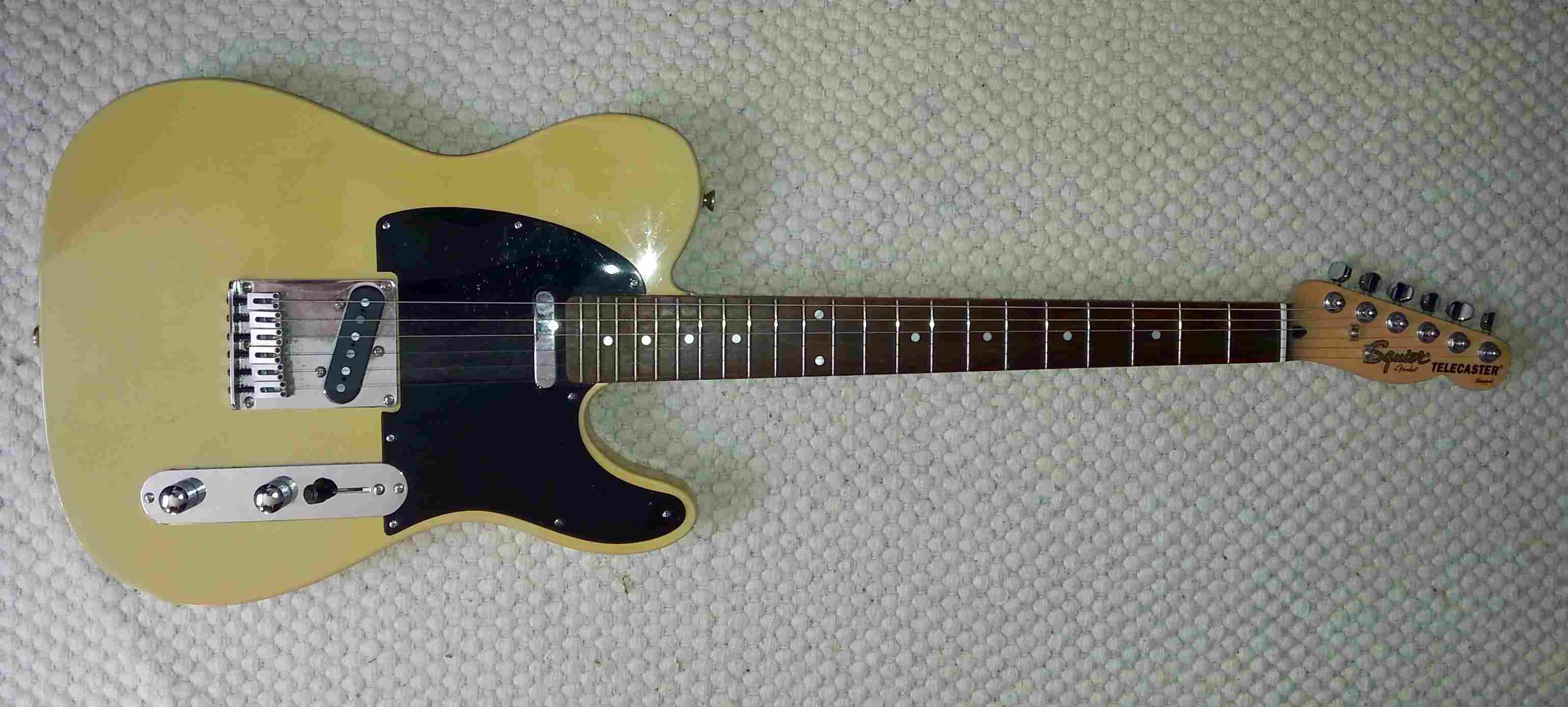
|
Not much to say. There are thousands of these guitars on the market. They are made in Indonesia by machines carving out the body
with high precision. Not much craftmanship there. But the precision ensures a guitar that is always precise and playable, and
with a "lipstick" neck pickup and single coil bridge, this is actually an enjoyable working mans instrument.
|
Epiphone Casino
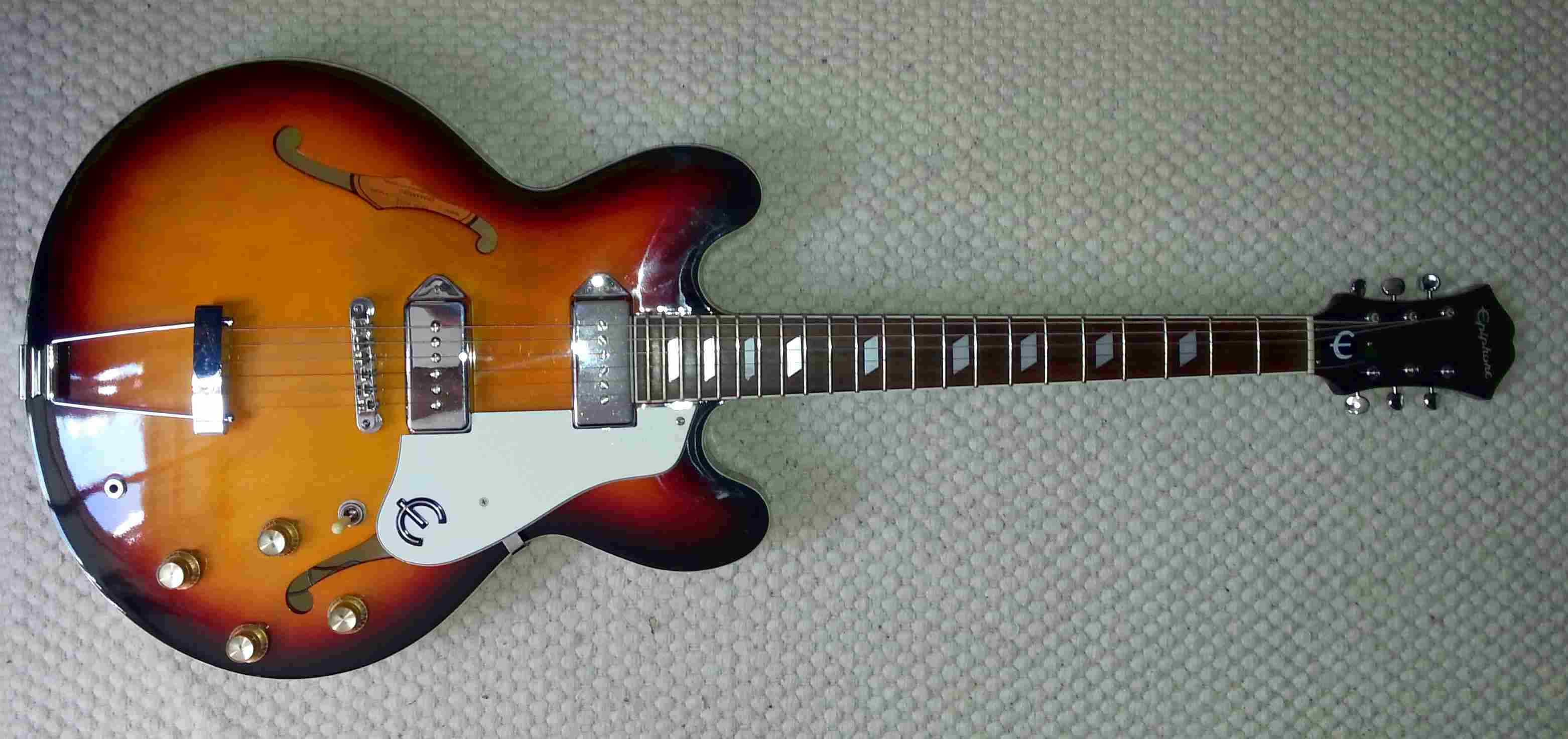
|
I wanted a hollowbody electric with powerful pickups. As indeed, I have a fondness for Beatle-related instruments, there was no
doubt in my mind that I was looking for an Epiphone Casino rather than the equivalent Gibson ES-335. Epiphone was an original
brand, but was bought by Gibson in the 50'ies. In the 60'ies they still contributed with their own take on the ES-335, the Casino.
This was a quality instrument that was adopted by McCartney, Lennon and Harrison.
In the 90'ies, when I went looking for a guitar, Epiphone was being established as Gibsons own budget brand, to compete with the
previous wave of japanese guitars. Now time had come to revisit the old Epiphone original models. A korean made Casino was issued,
and this is the one I ordered. I particularly liked the old tobacco burst finish that Lennons guitar had before he had it sanded
down, and the looks do not disappoint. I wish I could say the same about the build quality. The body is just too light. I thought it
might help to put genuine Gibson AlNiCo P90 pickups on it, but it still sounds muddy. I suspect the wood is not good enough.
With a little more patience, I should probably have waited for the japanese made John Lennon 1965 Casino that was issued later.
A much better instrument. The Casino to look for now is the Elitist Casino, which feels much heavier, and plays better. Made in
Japan, which has now become a mark of distinction!
|
Segovia acoustic 12-string
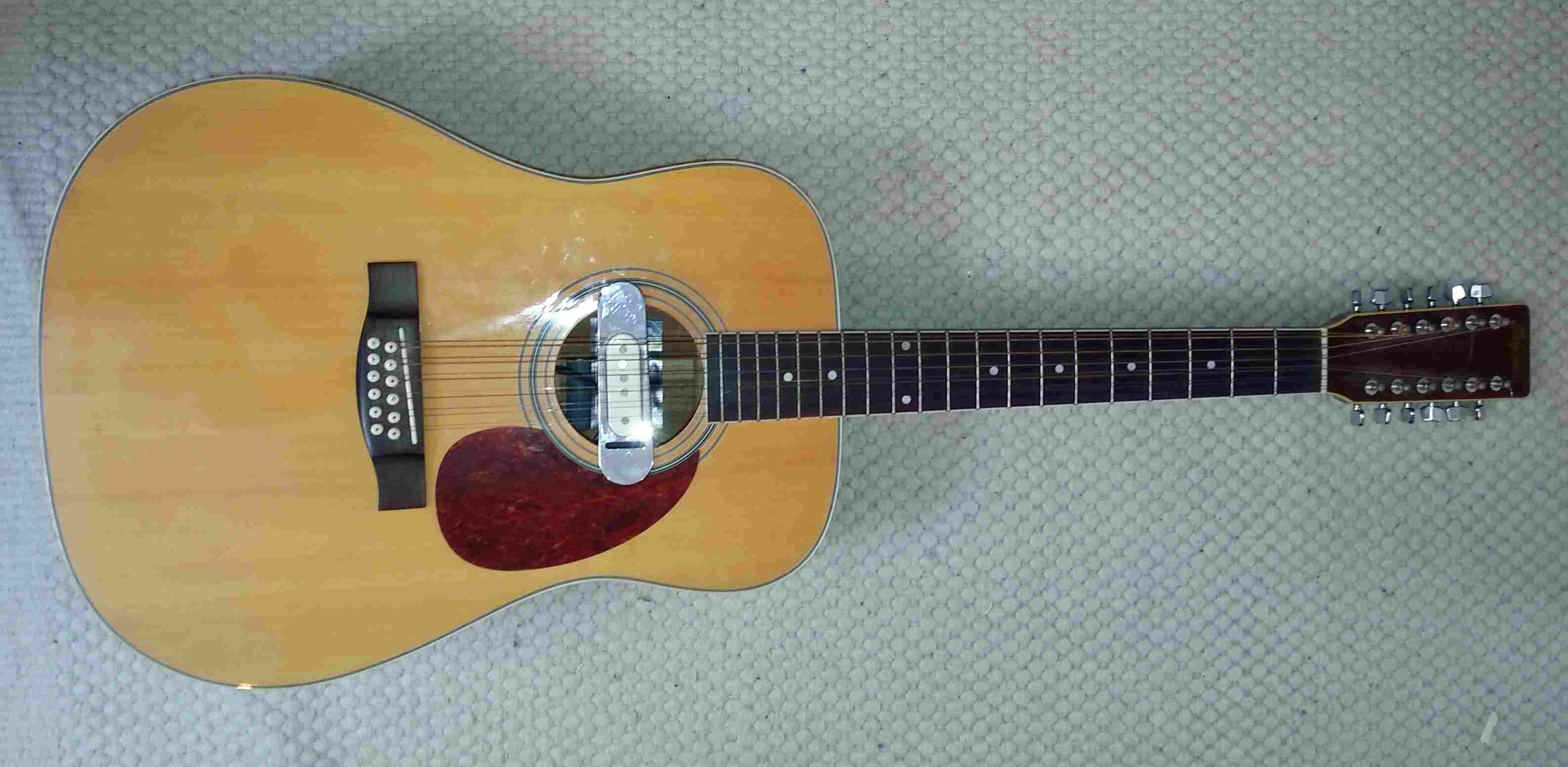
|
A nice 12-string accoustic made in Korea. Nothing special, but it sounds nice and plays well. Korea is one of the countries
that have taken over the role as budget instrument manufacturer, but they are capable of building nice and playable instruments.
|
Gianini spanish guitar
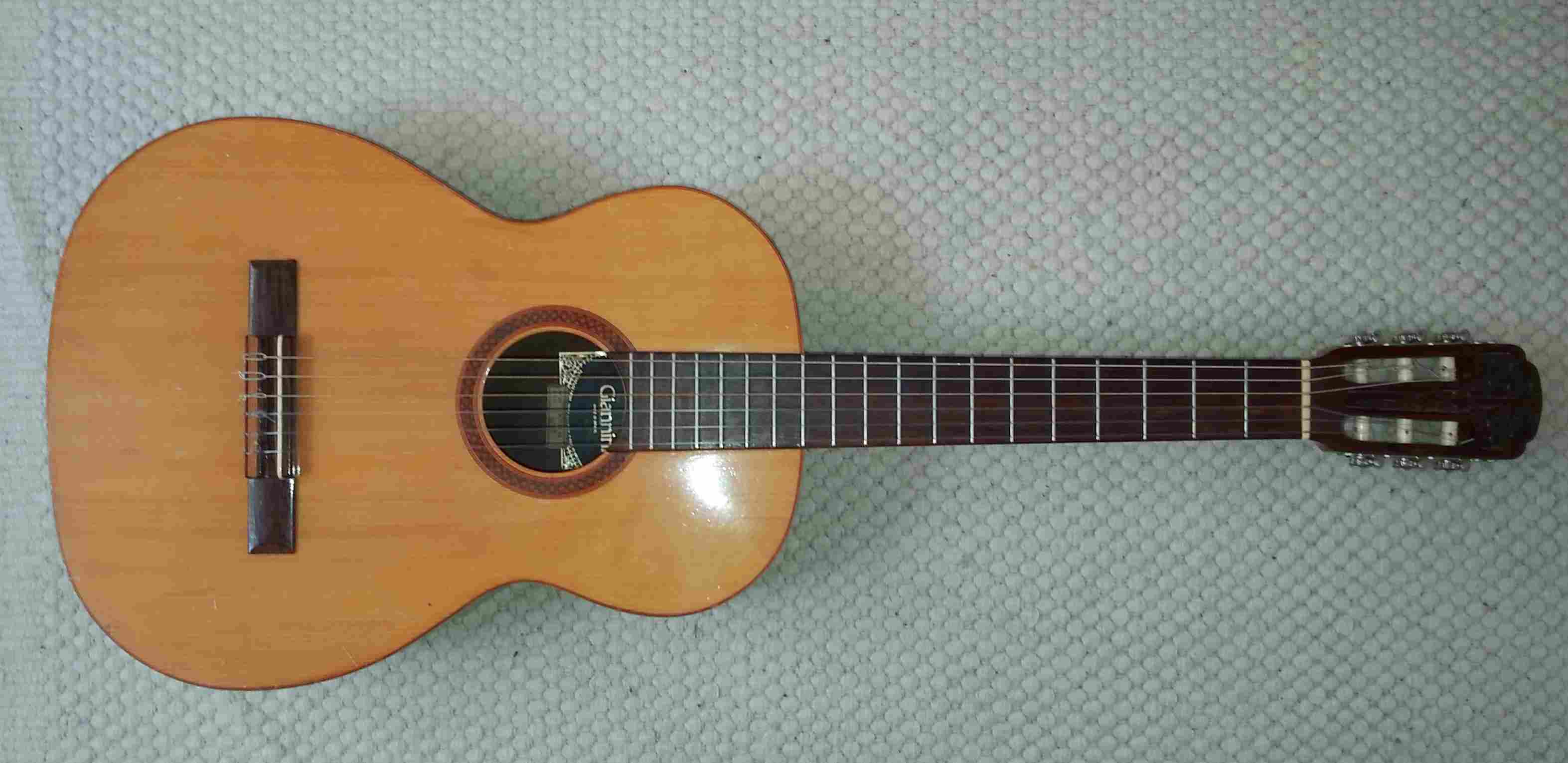
|
Another guitar from the mid-70'ies. This is my first spanish guitar. It was build in Brazil. It is a very cheap instrument,
and tone is less than spectacular. I still keep it though, as I learned classical guitar on it.
|
Guitarra Portuguesa 12-string
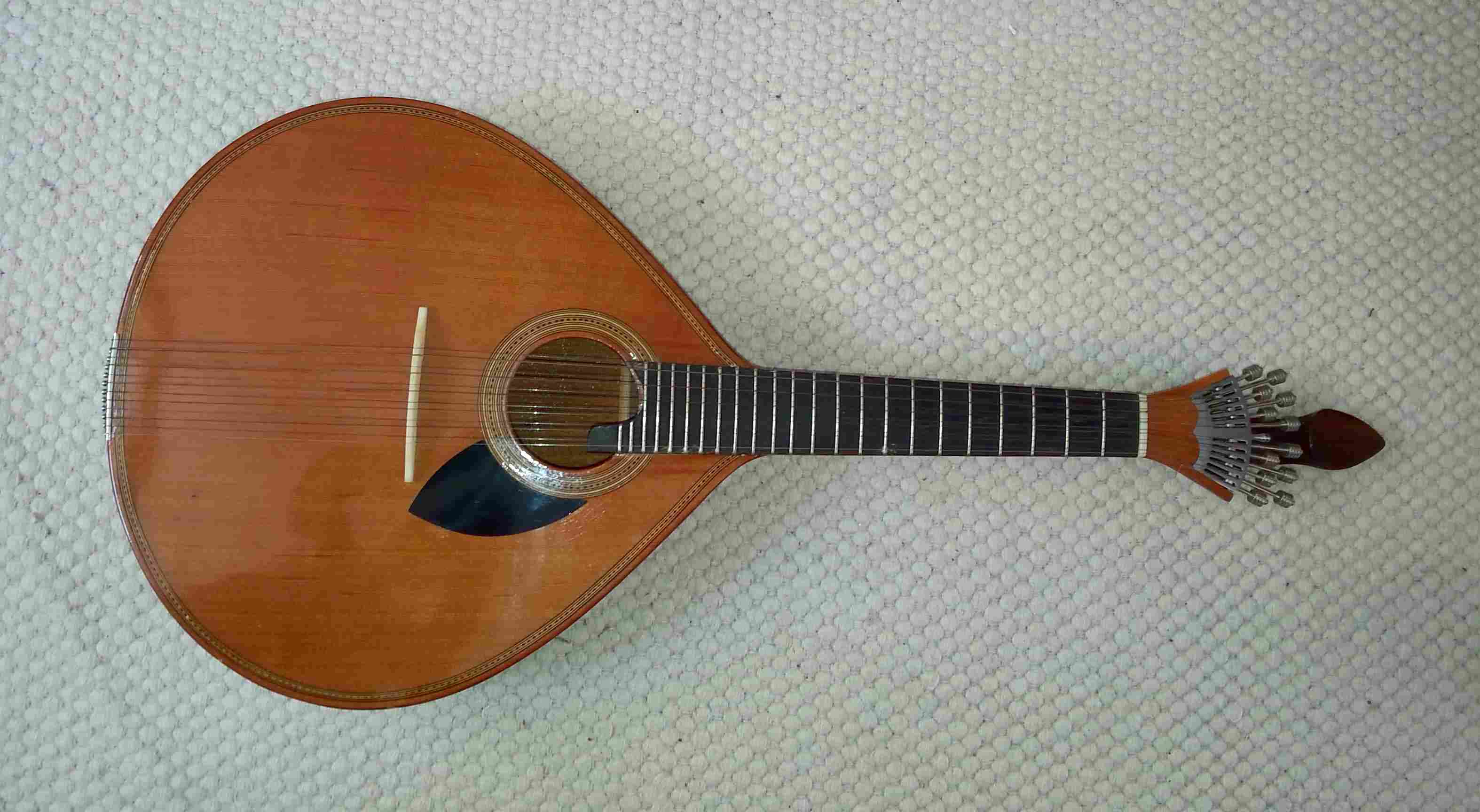
|
This is an unusual instrument from Portugal. It is the national instrument of the country, and I believe all instruments
of this type are hand build by portuguese makers. It also known under the name "Fado-guitar", due to its use in "Fado", the
traditional portuguese music.
It is in fact a descendent of a 16th century instrument called a "cistern" or "cittern", and is a close relative to another instrument called
"the english guitar". Could this be attributed to the close historical and political ties between Portugal and England perhaps?
In any case, the instrument has gone out of fashion elsewhere, but has a stronghold in Portugal.
Despite the lute-like shape, it is a 12-stringed guitar instrument with metal strings, a flat back, and tuned in one of
several unusual tunings. So it neither sounds or plays anything like a lute. The twelve tuning pegs are really screws,
that come out in a radial shape, and drive twelve small sledges with the strings fastened. A system know as "Preston tuners".
The instrument exists in two main types; a smaller and brighter Lisbon guitar and a larger Coimbra guitar which is tuned in a darker register.
This one is a Coimbra type. I think mine is a beginners guitar, but even the beginners guitar has that unmistakable piercing
mandolin-like sound so characteristic for portuguese music.
I bought this guitar in Portimao, Algarve, 10 years ago, and I have no idea who the maker is. Only thing I can say for sure is that it
is a hand-made instrument.
|















